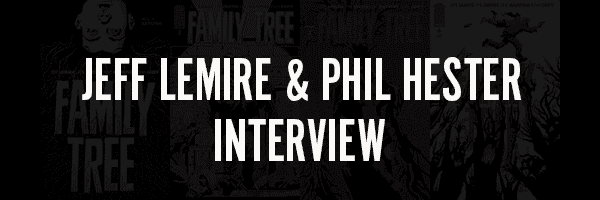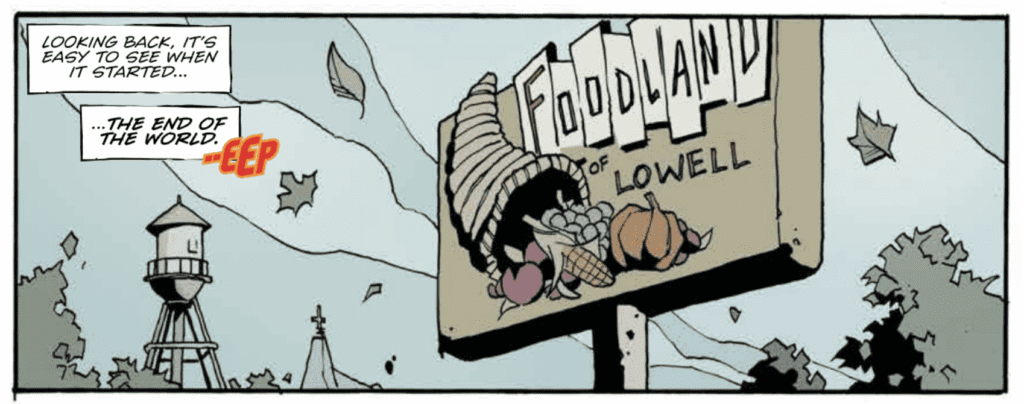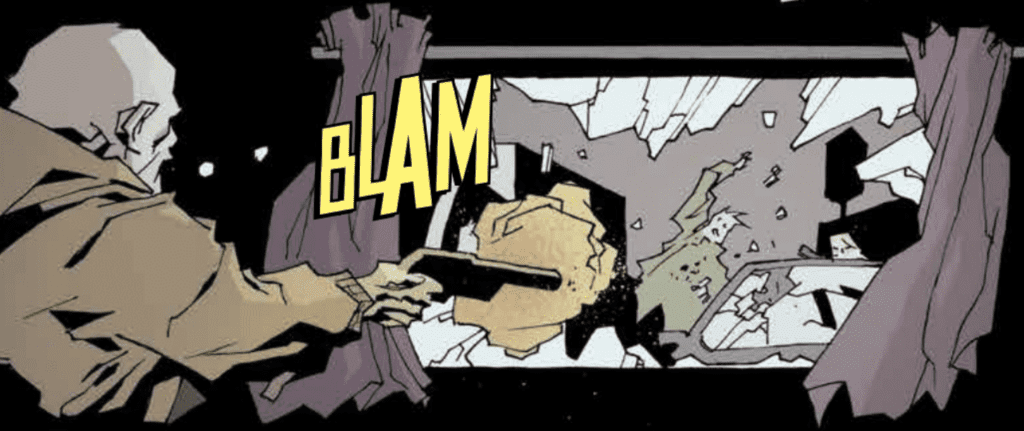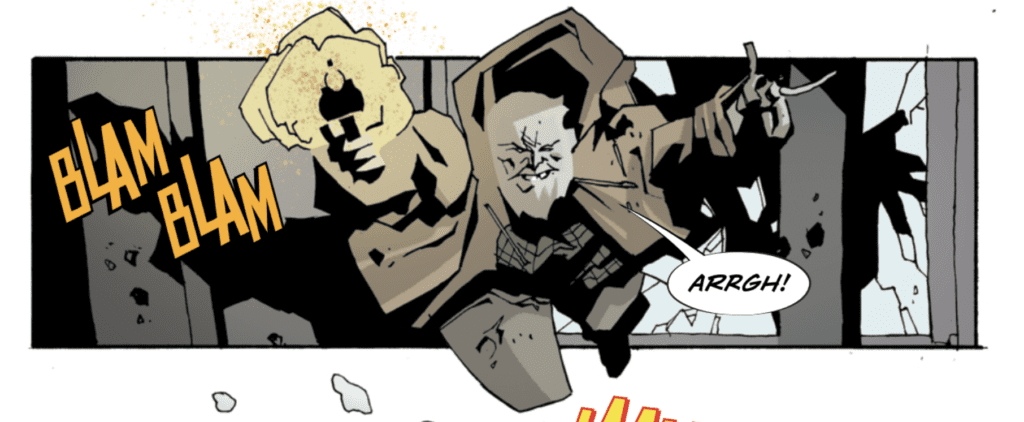Family Tree, Vol. 1: Sapling hits your local comic book shop this week, but thanks to Image Comics, Monkeys Fighting Robots gets a chance to explore the creative relationship between Jeff Lemire And Phil Hester.
About the book:
When an eight-year-old girl begins to transform into a tree, her single Mom, troubled brother, and possibly insane Grandfather embark on a bizarre and heart-wrenching odyssey across the back roads of America, desperately searching for a way to cure her horrifying transformation before it’s too late.
You can read the first issue of Family Tree online.

MFR: With the recent pandemic, we’ve seen a real-world example of how people react to pestilence. That’s something you begin to tackle with FAMILY TREE, along with the world feeling like it’s coming to an end. How do you feel when life is crazier than art?
LEMIRE: It’s very surreal to have written something like this right before the pandemic, that’s for sure. I did echoes of Family Tree in the way that things developed during the pandemic, mostly in how fast things moved and how it was just beyond our control, and we were swept up in it, much like the characters in the book.
HESTER: In all honestly, it’s no fun. I feel like horror works best when it comes back to the reader through a lens that allows them to separate a little, to see it in the abstract. I think that little bit of stagecraft makes the themes easier to process. When you’re hitting the exact same notes as the nightly news, it can get a little depressing. Thankfully, the series goes way, way beyond a typical pandemic tale, and enters a sort of metaphysical realm that may serve as the “lens” I was rambling about at the beginning of this answer forty years ago.

MFR: Jeff, From early on in this series, we get a real sense that we shouldn’t judge the otherworldly so quickly. While our gut instinct is to be afraid, that’s sometimes ill-founded. This is a theme in a lot of your work, like SWEET TOOTH, BLACK HAMMER, and ANIMAL MAN. FAMILY TREE is another brilliant example. What draws you to this theme and keeps bringing you back?
LEMIRE: Seeing the beauty in horror and in unusual things is something I’ve always been drawn to. I also like subverting expectations when I can as a storyteller, so I think it comes from both those places. In the case of Family Tree, I was really drawn to the idea of a return to nature and that maybe, in some ways, we would be better off if that happened.
MFR: Speaking of ANIMAL MAN, there seem to be traces of SWAMP THING here. Is there a SWAMP THING influence, and if so, can talk about why it resonates with you?
LEMIRE: I suppose the nods to Swampy are obvious. I have always loved that book and that character and, ironically, the first time I saw Phil’s work was when he was drawing Swamp Thing. I love the aesthetic of the character, but I also loved how Alan Moore used him as a vehicle to explore things beyond just the genre trappings. I try to do that in my work too.

MFR: Phil, many of these characters have a rough and tumble look about them. It seems to be an extension of his or her personality, and it works very well. Did you plan for this world to have that kind of vibe, or was that something you discovered as you sketched out the characters?
HESTER: I know what the story was about before I started, so the idea of very “lived-in” characters seemed appropriate. They’ve all been through a lot, and are headed for worse, so I wanted to show that wear and tear on them, especially Judd, who has officially one of my favorite characters to draw in my career.
MFR: Phil, the panels in FAMILY TREE are continually changing shape and function. They jump off the page and feel intrinsically linked to the storytelling. How do you feel this approach has lent itself to the series as opposed to a more traditional approach?
HESTER: The story has a very dreamlike, inescapable tone to it. It’s like when you can’t run in a nightmare, but find yourself being dragged inexorably toward what you’re trying to avoid. I want every page, or at least every scene, to have that kind of yawning vortex vibe about it. The pages have a lot of open ends and deep whorls that you sort of fall into as a reader. I want the readers to be trapped in this comic.
MFR: When you’re plotting, outlining, and designing the characters and their world, how do you approach an original story compared to something at Marvel or DC?
LEMIRE: We certainly have more freedom to just build it all from the ground up and not have to fit it into anyone else’s vision or world. It really comes down to that, the freedom to explore ideas and to write and draw for ourselves and each other rather than a publisher.
HESTER: Frankly, I approach them the same way. It’s just that at the Big Two, there are more people to rein me in.

MFR: You both write AND draw – how does that impact or change your dynamic and collaboration process? Do either of you approach this project differently than you would with a partner who strictly writes OR draws?
LEMIRE: For me, I think it just means giving Phil the freedom to tell the story visually. I know he is a great writer and storyteller, so I don’t need to focus too much on trying to dictate that in my scripts. Rather, I just need to give him the framework to do what he does so well, and then I get to focus on plot and character and dialogue.
HESTER: I think it helps us respect the other person’s effort a bit more. I know where the line is as a collaborator. If Jeff asks for something in a script, I know that he needs it. He’s been on my side of the equation, so he’s not going to ask for anything that’s not crucial.
MFR: FAMILY TREE has a good amount of white space, can you talk about the color palette Ryan Cody used in the first volume?
HESTER: Ryan’s been great. When we were trying to find the right palette, I kept pushing him to wash out the colors even more, almost to the point the book barely had color at all. He found that groove and became a master of it. Like I said earlier, I want this book to feel like a dream, so it’s pretty important to me that the color be non-literal. It should only make sense in the context of the book. Ryan’s mastered that, as has Eric Gapstur on inks. Every itchy line I lay down gets even itchier when I get it back from Eric.

MFR: By the end of the first volume, Steve Wands’ “BLAM” becomes so iconic and jumps off the page during action sequences. What’s it feel like when the story, art, and letters work in harmony during an intense action sequence like at the end of the first volume?
LEMIRE: That all comes from trust. Letting every member of the creative team contribute and do their thing. When you do that, it allows for everyone to feel like a real team, and hopefully that shows on the page.
HESTER: It’s a joy to see everyone firing on all cylinders. Steve letters so many books that I’m always amazed at how he never loses focus regarding what makes this project special.
MFR: With the COVID-19, the comic book industry is at an evolutionary moment. What do you think the comic book industry will look like in 10 years?
LEMIRE: Obviously it won’t matter because the world will be covered in human trees by then.
HESTER: No one knows, especially anyone telling you they do.
Have you been reading Family Tree? Comment below with your thoughts.
Family Tree #4 was an alarming and dramatic issue, one that was unafraid to show the brutality and desperation that comes from fighting for your life. This is an issue that will leave fans on the edge of their seat, waiting for the fifth issue to drop. – Cat Wyatt

